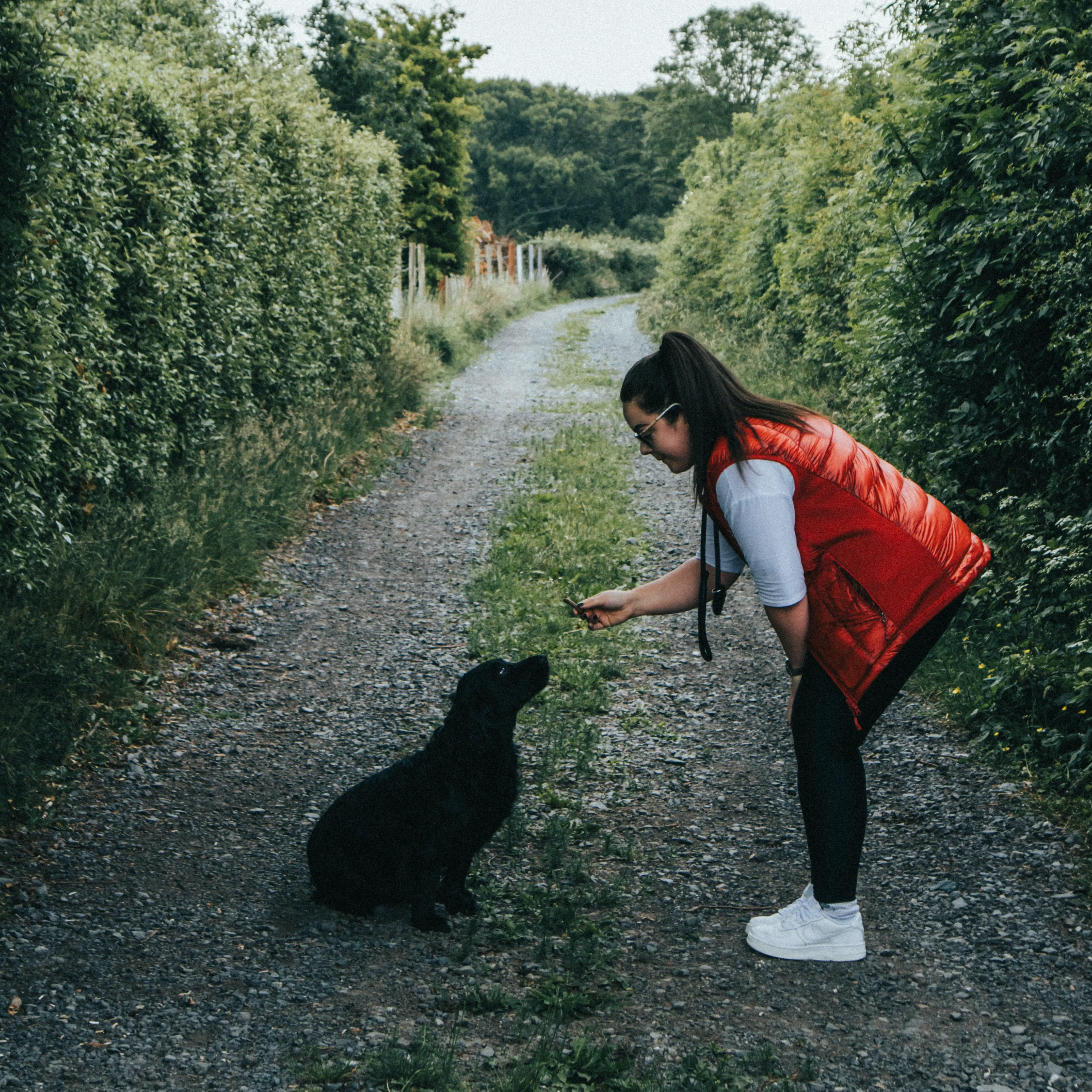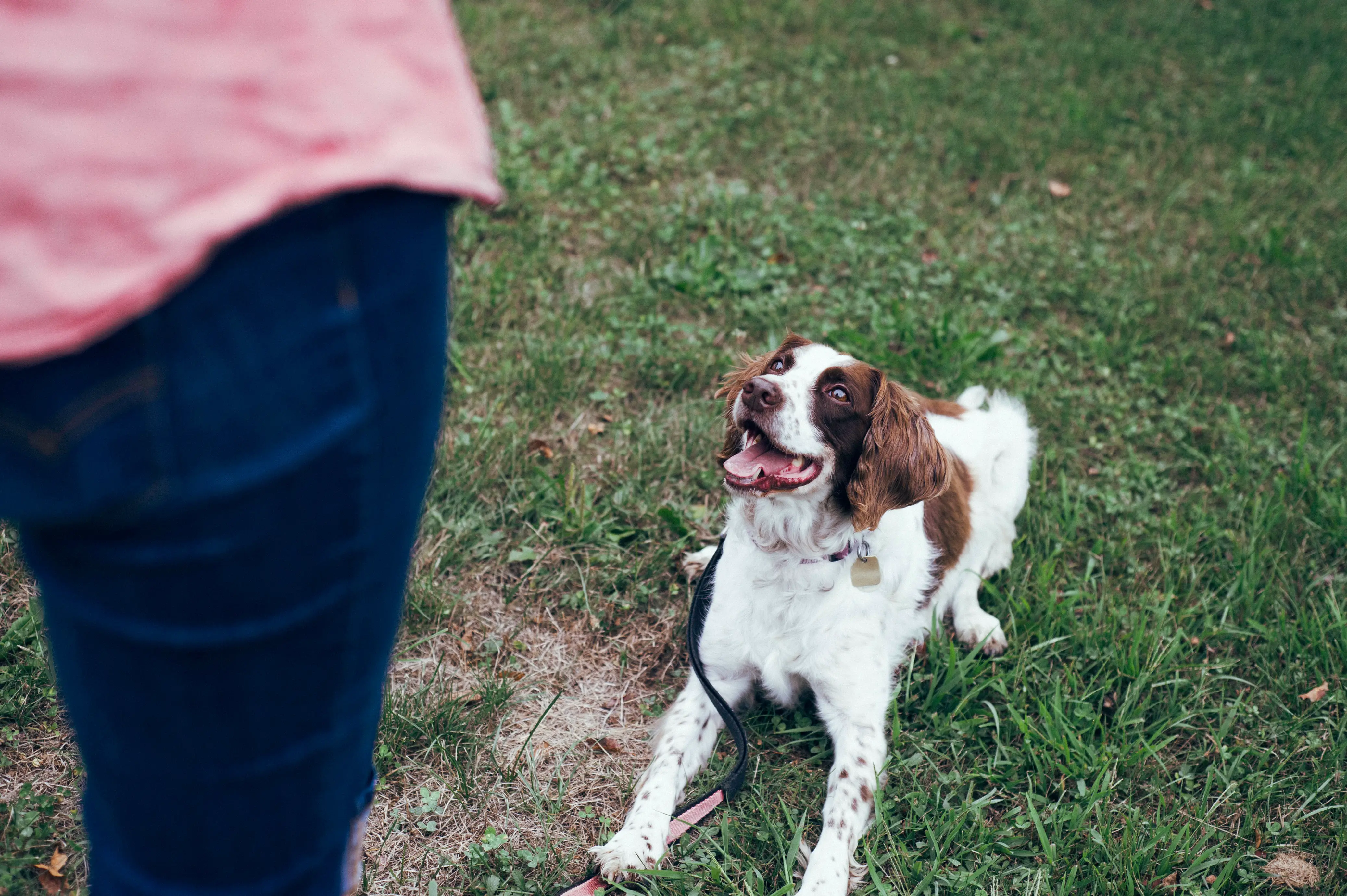Positive reinforcement is an approach to training animals that adds something the animal desires to increase their likelihood of repeating that positive behavior. This approach can be used with cats, birds, and dogs to name a few. Another name for positive reinforcement training is reward-based training.
Dogs respond well to positive reinforcement as they can be given rewards such as food, play toys, or really anything of high value to the dog. The reasoning behind learning how to train your dog with positive reinforcement is dogs will repeat behaviors quicker after receiving a reward.
Examples of Positive Reinforcement: You give the “sit” command, and after your dog is in the sit position, you treat them. Another example is when your dog retrieves a toy, they bring it back to your hand, you give them a reward (or treat).
In contrast, the opposite of positive reinforcement is negative reinforcement. This approach to training is taking something of value away from the dog. Tugging on the leash, physically moving your dog into a sit position, and the use of electronic shocks given at the neck would all be considered negative reinforcement training.
Related Articles:
- Basic Dog Training Commands
- How to Properly Carry a Dog
- How To Take Care Of A Puppy
- How To Take Care Of A Dog
- How to Obedience Train Your Dog
Example of Negative Reinforcement: When teaching your dog to walk with a loose leash and the dog pulls on the leash or walks too far away from you. Negative reinforcement is the dog will get repetitive tugs and pressure on the leash until they come back to your side.
When you choose the positive training approach, it’s vitally important you are careful about what behaviors you reinforce in your dog. Behaviors that are undesirable are ignored with an opportunity for the dog to offer up the correct behavior.
In this article, How to Train Your Dog with Positive Reinforcement, we will look at five tips that will enable you to see more success with this approach to training your dog.

5 Tips for How to Train Your Dog with Positive Reinforcement
- Choosing Rewards
- Timing the Reward
- Reward Placement
- Quantity or Rate of Rewards
- Consistency of Positive Reinforcement
How to Train Your Dog with Positive Reinforcement: Choosing Rewards
What kind of rewards are used in positive reinforcement? Ideas for rewards could include tasty treats, toys, games, sniffy walks, privileges, and verbal praise. The reward needs to be based on what your dog finds rewarding, not the trainer.
Dogs that are food motivated find most treats to be rewarding. However, there are high value treats and then just plain treats. The quality of treat makes a world of difference to your dog.
In human terms, would you find a spoonful of broccoli rewarding or a piece of chocolate? Both are food but hold different values to each individual person.
Related Articles:
- How to Get the Attention of a Deaf Dog
- How to Train a Deaf Dog to Sit and Stay
- How to Train a Deaf Dog with Hand Signals
- How to Potty Train a Deaf Dog
As you get to know your dog, make a list of what they find enjoyable. When putting into practice how to train your dog with positive reinforcement you will use the high value rewards for new skills or new behaviors you would like to see again.
High value rewards are appropriate when your dog can respond well to distractions during training as well as bigger training challenges.
When learning and putting into practice positive reinforcement training, the timing of the reward is just as important as the quality of the reward.
How to Train Your Dog with Positive Reinforcement: Timing the Reward
Rewarding your dog with treats and quality playtime is just one element when learning how to train your dog with positive reinforcement. The delivery of the reward and timing of the reward play huge roles in the effectiveness of the training.
What exactly does timing the reward mean? In order to reinforce your dog’s positive behavior, your timing needs to be just right. Deliver the reward as quickly as possible after your dog exhibited the behavior you want to acknowledge.
Example: Your dog is learning to stay in the “down” position. After your dog goes into a lay down, you place a treat between their paws immediately. Wait a few seconds and treat them again for staying in the down position.
Related Articles:
- How to Cook Liver for Dogs
- How to Get a Picky Dog to Eat
- How to Stop Your Dog from Peeing When Excited
- How to Keep Your House from Smelling like Dog
- How to Measure a Dog for a Harness
The more accurate the timing of the delivery of the reward will allow for better reinforcement of the behavior and less confusion for the dog. Naming a repeated behavior with the reward will allow for better accuracy. “Down – give treat”.
One simple tip that compliments the delivery of the reward, if using treats, is allow your dog to chew his treat. You treat your dog for walking nicely by your side, stop, treat, and let them chew and continue walking. Repeat.
Positive reinforcement training is all about choosing the right value of reward to match the correct behavior. It is also most effective to time your reward with accuracy. The next tip for learning how to train your dog with positive reinforcement is the placement of the reward.

How to Train Your Dog with Positive Reinforcement: Reward Placement
Positive reinforcement training is most effective when using a quality high value reward, rewarding immediately and knowing where to place your reward.
As mentioned earlier in this article, how learning how to train your do with positive reinforcement training includes where you give your reward. When your dog is in the “down” position, immediately place the reward between their front paws and name the position “down”.
Example of placement of the reward: You are teaching your dog “stay”. While your dog is in the sit or down position, step away from your dog (the distance could be an inch or twelve inches), they remain in the position, treat, and say “stay”. Repeat, gradually moving further away from your dog.
Related Articles:
- Ultimate Guide: How To Take Care Of A Puppy
- Ultimate Guide: How To Take Care Of A Dog
- Ultimate Guide: How To Take Care Of A Senior Dog
- The Benefits of Owning a Dog
- Top 12 Tips for First Time Dog Owners
- How to Train a Dog
The key to using reward placement is only rewarding for the exact behavior you want to see repeated. When you are teaching “stay” and your dog moves when you move away from them, they do not get a treat. Place them back in a sit or down and try again.
Some people and trainers find value in teaching their dog to catch a treat from a distance. Once they see the behavior they like, they can toss their dog a treat immediately and their dog gets a reward. This type of placement rewards can be effective when teaching your dog to stay on their dog bed or go to their dog bed.
The next tip when practicing how to train your dog with positive reinforcement is knowing how many rewards (or treats) to administer at one given moment.
How to Train Your Dog with Positive Reinforcement: Quantity / Rate of Rewards
Now that you are beginning to see a pattern of using quality rewards along with the timing and placement of the reward, next is the quantity of reward.
Exactly how many rewards are necessary when reinforcing a behavior? The quantity or rate of rewards is going to defer for every dog. For a dog that has a difficult time learning to walk on a loose leash, and they begin to do just that, the reward will be great.
Related Articles:
- Can Dogs Eat Shrimp?
- Can Dogs Eat Broccoli?
- How to Cook Marrow Bones for Dogs
- How to Cook Liver for Dogs
- How to Get a Picky Dog to Eat
- How to Get Your Dog to Eat
Example of Rate of Rewards: Your dog is just learning to walk nicely with a loose leash by your side. While out walking your dog, you walk past a squirrel in a nearby tree. Your dog might look away for a second but immediately directs their attention back to you and continues to walk nicely. Stop and treat that behavior with several treats one right after another.
Some trainers even refer to this as giving your dog a “jackpot” reward. Your dog keeps a long stay with distraction, you walk back to your dog and give them one treat after another. The treats might even be reinforced with the word “stay”.
It’s clear to your dog that they performed a skill that was positive or a pleasing behavior. Positive reinforcement training is essentially communicating to your dog through rewards what is acceptable behavior in your world.
The last tip for teaching how to train your dog with positive reinforcement is controlling your environment.
Related Articles:
- A Review Of The Top 5 Best Salmon Oils for Dogs
- The Best Canned Dog Food for Dogs with Sensitive Stomachs
- How to Cook Liver for Dogs
- A Review of the 5 Best High Fiber Dog Foods For Anal Gland Problems

How to Train Your Dog with Positive Reinforcement: Control Your Environment
The environment you chose to train your dog in is important. When first starting out with teaching positive reinforcement training, chose an environment that is comfortable for your dog. An environment with fewer distractions is helpful.
Most people like to begin training their dog in their home. Your dog will know what behaviors are acceptable and desired in your living space. The next recommended environment is outside your home, perhaps in your yard, on a deck or walking the sidewalk in front of your living space.
Continue to challenge you and your dog while using positive reinforcement training and train your dog at a local park. Pack along more rewards for new environments.
Keep in mind positive reinforcement training is very effective with teaching a dog a skill or behavior in a short amount of time. Ironically part of training a dog is training yourself in the most effective way to train.
Patience and consistency are two qualities needed as you learn how to train your dog with positive reinforcement.
Related Articles:
- A Review Of The Top 5 Best Dog Whistles
- A Review of the 5 Best Dog Muzzles
- A Review Of The Top 5 Best Dog Clickers
- How to Build an Outdoor Dog Potty Area on Concrete
Please read our Legal Disclaimer

